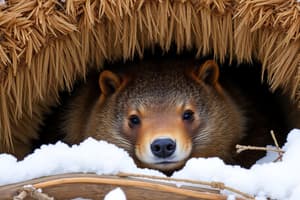Podcast
Questions and Answers
What is the primary characteristic of hibernation?
What is the primary characteristic of hibernation?
- Increased activity and metabolic rate
- Consistent body temperature throughout the year
- Minimal activity and metabolic depression (correct)
- Increased food consumption
What is the difference between obligate and facultative hibernation?
What is the difference between obligate and facultative hibernation?
- Obligate hibernators have a longer hibernation period, while facultative hibernators have a shorter hibernation period.
- Obligate hibernators are found in tropical regions, while facultative hibernators are found in temperate regions.
- Obligate hibernators have a higher metabolic rate, while facultative hibernators have a lower metabolic rate.
- Obligate hibernators enter hibernation spontaneously and annually, while facultative hibernators only enter hibernation when stressed or food-deprived. (correct)
How do hibernating animals avoid muscle atrophy and dehydration?
How do hibernating animals avoid muscle atrophy and dehydration?
- They recycle their proteins and urine, and metabolize fat to stay hydrated. (correct)
- They rely on their stored energy reserves and do not need to consume any food or water during hibernation.
- They enter a state of complete inactivity, which prevents muscle atrophy and dehydration.
- They increase their food intake and water consumption during hibernation.
Why was the discovery of hibernation in the fat-tailed dwarf lemur of Madagascar significant?
Why was the discovery of hibernation in the fat-tailed dwarf lemur of Madagascar significant?
What is the primary reason why hibernating animals do not eat or drink while hibernating?
What is the primary reason why hibernating animals do not eat or drink while hibernating?
What is the significance of Malagasy winter temperatures sometimes rising above 30°C (86°F) for the hibernation of the fat-tailed dwarf lemur?
What is the significance of Malagasy winter temperatures sometimes rising above 30°C (86°F) for the hibernation of the fat-tailed dwarf lemur?
Flashcards are hidden until you start studying
Study Notes
Hibernation Characteristics
- Hibernation is a state of minimal activity and metabolic depression
- Characterized by low body temperature, slow breathing, and heart rate, and low metabolic rate
Types of Hibernation
- Obligate hibernation: occurs spontaneously and annually, regardless of ambient temperature and access to food
- Facultative hibernation: occurs only when cold-stressed, food-deprived, or both
Hibernation in Primates
- Until recently, no primate or tropical mammal was known to hibernate
- Fat-tailed dwarf lemur of Madagascar hibernates in tree holes for seven months of the year
- Hibernation not exclusively an adaptation to low ambient temperatures, as Malagasy winter temperatures can rise to over 30 °C (86 °F)
Hibernation Adaptations
- Recycling of proteins and urine allows hibernators to stop urinating for months and avoid muscle atrophy
- Metabolic fat produced in sufficient quantities to satisfy water needs
- Hibernators do not eat or drink while hibernating, but live off stored fat
Studying That Suits You
Use AI to generate personalized quizzes and flashcards to suit your learning preferences.




